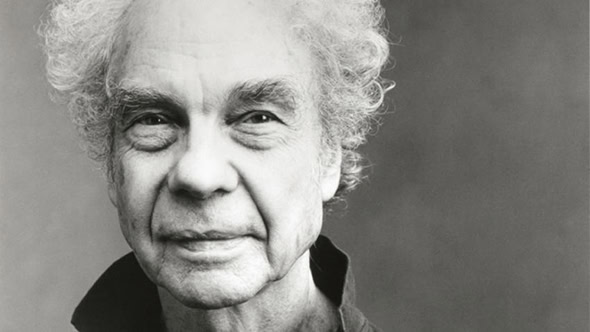Merce Cunningham Centennial: Night of 100 Solos
Posted: April 21st, 2019 | Author: Nicholas Minns | Filed under: Performance | Tags: Anton Lukoszevies, Asha Thomas, Ashley Chen, Beatriz Stix-Brunell, Catherine Legrand, Cheryl Therrien, Christian Marclay, Christian Wolff, Daniel Squire, Edwin Denby, Francesca Hayward, John Cage, John Lely, Jonathan Goddard, Joseph Sissens, Julie Cunningham, Merce Cunningham, Michael Nunn, Mira Benjamin, Siobhan Davies, Toke Broni Strandby, William Trevitt | Comments Off on Merce Cunningham Centennial: Night of 100 SolosThe Merce Cunningham Centennial, Night of 100 Solos, Barbican, April 16

To celebrate the centenary of Merce Cunningham’s birth on April 16, the Merce Cunningham Trust live-streamed three shows in three cities (Los Angeles, New York and London) that each presented 25 dancers performing 100 solos from the Cunningham repertoire. In London’s Barbican, where the Merce Cunningham company had performed regularly for the last 20 years of its life, Daniel Squire (with help from Ashley Chen and Cheryl Therrien) arranged extracts from 54 works, the earliest being Dime a Dance (1953) and the latest Nearly Ninety (2009), to fit within a 90-minute format. The idea of presenting solos as a collage without the context of their parent works follows one that Cunningham had devised whenever the company performed in a non-theatrical venue like an art gallery or a gymnasium. Despite the paradox of creating this event in a proscenium theatre it nonetheless offers an opportunity to savour the extraordinary richness of Cunningham’s choreographic thinking over a fifty-year period. As dance critic Edwin Denby wrote in 1968, ‘Seeing Merce is always a very great pleasure.’
Denby had attended Cunningham’s very first program of solo dances in New York in April 1944, describing their effect as ‘one of an excessively elegant sensuality’ that contrasted with ‘one of remoteness and isolation’. These two qualities, both alone and in combination, could well define the range of solos chosen for the Barbican along with an all-embracing sense of playfulness and wit that point to one of the basic tenets of Cunningham’s work. In his last recorded interview with Nancy Dalva Cunningham responds with the nonchalance of accumulated wisdom to a question about what dance means to him: ‘We look out at life and that’s dance.’
The Cunningham company was famously disbanded as part of its founder’s legacy plan following his death in 2009, so although there are seasoned performers like Squire and Julie Cunningham on hand, this centennial celebration is staged with dancers who have never been part of Cunningham’s company even if some of them have studied his technique. The Merce Cunningham Trust explains that ‘in each city, a former dancer experienced in creating Cunningham Events will work with an associate stager and other Merce Cunningham Dance Company alumni to impart the choreography to a new generation of dancers.’ There is more public relations than clarity in this statement as such luminaries as Siobhan Davies, Michael Nunn, William Trevitt, Catherine Legrand and Asha Thomas, while absorbing to watch, are hardly a new generation of dancers. Apart from sharing the centennial with a global audience (those who missed it can watch the live stream from all three cities online until July 19) Night of 100 Solos is also advance publicity as well as a preview for a raft of Cunningham performances later this year that the Merce Cunningham Trust has generously offered to companies and festivals free of licensing fees. In the UK these include Dance Umbrella, Rambert and the Royal Ballet; London, at least, will be spoiled for choice.
The PR nature of Night of 100 Solos clarifies the choice of performers; we can expect to see them again later this year in a Cunningham work on one of three continents — hopefully with a contingent of company alumni too. It will be interesting to see how the Royal Ballet will deal with Cunningham’s work. While his choreography borrows from many sources that include the classical ballet canon his technique can prove challenging to classically trained dancers. In teaching the body to ‘move in any direction at any speed, without hesitation, without stammering’ (to quote Denby again), his technique is more akin to the requirements of Astaire than to those of Petipa. Watching Francesca Hayward, Beatriz Stix-Brunell and Joseph Sissens in their solos is to see a concentration on form struggling with the dynamics of freedom; Cunningham makes the body dance to its own rhythm and allows us to watch whereas classical ballet both relies on a musical score for its expression and demands our attention. Toke Broni Strandby in his solo with the chair and Jonathan Goddard in his soft shoe shuffle demonstrate how deliciously translatable Cunningham can be.
The influence on Cunningham of his creative and life partner John Cage, who died in 1992, was abundantly present in the sophisticated playfulness of the five musicians in the pit: Mira Benjamin (violin), John Lely (objects and electronics), Anton Lukoszevies (cello), Christian Marclay (turntables and objects) and coordinator Christian Wolff (piano, melodica, objects). To paraphrase Cunningham, what you’re hearing is what it is.